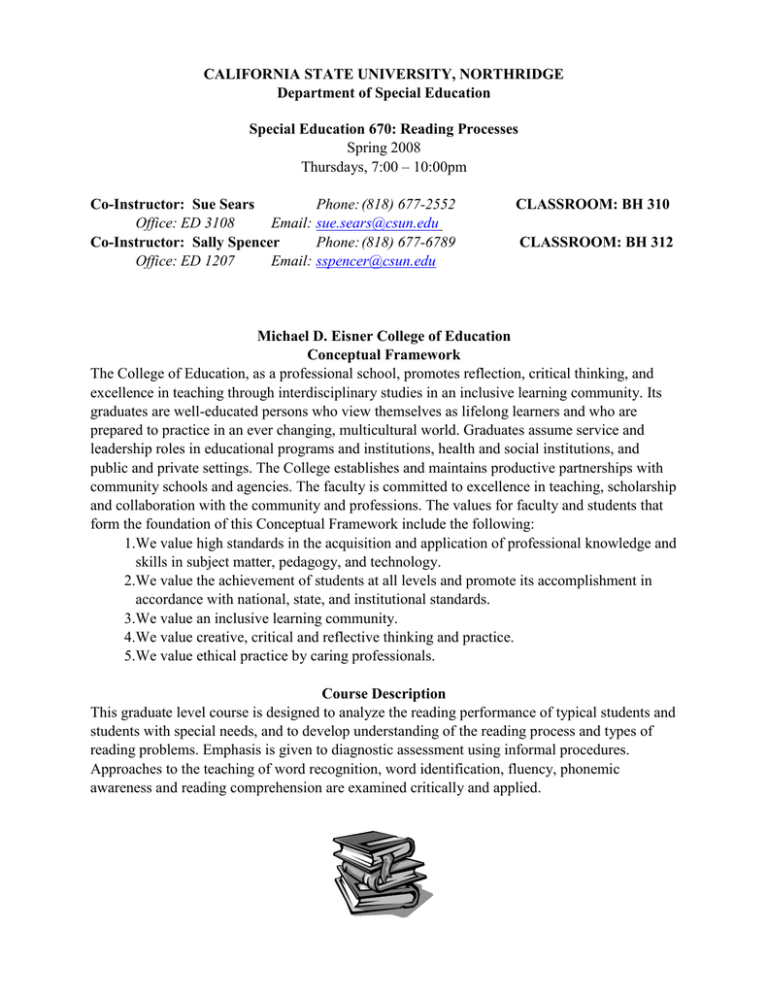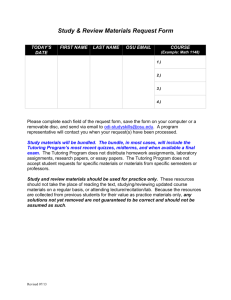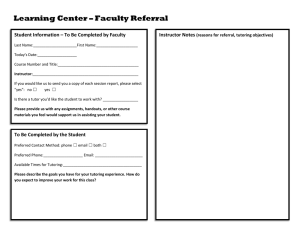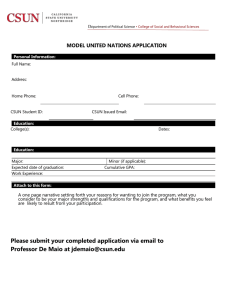
CALIFORNIA STATE UNIVERSITY, NORTHRIDGE
Department of Special Education
Special Education 670: Reading Processes
Spring 2008
Thursdays, 7:00 – 10:00pm
Co-Instructor: Sue Sears
Phone: (818) 677-2552
Office: ED 3108
Email: sue.sears@csun.edu
Co-Instructor: Sally Spencer
Phone: (818) 677-6789
Office: ED 1207
Email: sspencer@csun.edu
CLASSROOM: BH 310
CLASSROOM: BH 312
Michael D. Eisner College of Education
Conceptual Framework
The College of Education, as a professional school, promotes reflection, critical thinking, and
excellence in teaching through interdisciplinary studies in an inclusive learning community. Its
graduates are well-educated persons who view themselves as lifelong learners and who are
prepared to practice in an ever changing, multicultural world. Graduates assume service and
leadership roles in educational programs and institutions, health and social institutions, and
public and private settings. The College establishes and maintains productive partnerships with
community schools and agencies. The faculty is committed to excellence in teaching, scholarship
and collaboration with the community and professions. The values for faculty and students that
form the foundation of this Conceptual Framework include the following:
1.We value high standards in the acquisition and application of professional knowledge and
skills in subject matter, pedagogy, and technology.
2.We value the achievement of students at all levels and promote its accomplishment in
accordance with national, state, and institutional standards.
3.We value an inclusive learning community.
4.We value creative, critical and reflective thinking and practice.
5.We value ethical practice by caring professionals.
Course Description
This graduate level course is designed to analyze the reading performance of typical students and
students with special needs, and to develop understanding of the reading process and types of
reading problems. Emphasis is given to diagnostic assessment using informal procedures.
Approaches to the teaching of word recognition, word identification, fluency, phonemic
awareness and reading comprehension are examined critically and applied.
1
Course Texts
Bear, D.R., Invernizzi, M., Templeton, S., & Johnston, F. (2008). Words their way: Word study
for phonics, vocabulary, and spelling instruction. Columbus, OH: Pearson/Prentice Hall
(4th Ed.).
Leslie, L., & Caldwell, J. (2005). Qualitative reading inventory-4. New York: Addison Wesley
Longman (4th Ed.).
Purcell-Gates, V. (1995). Other people’s words: The cycle of low literacy. Cambridge: Harvard
University Press.
Stahl, S.A. (1999). Vocabulary development: Reading research to practice (Vol. 2). Brookline,
MA: Brookline Books.
Tovani, C. (2000). I read it but I don’t get it. Portland, ME: Stenhouse Publishers.
Selected readings will be available on-line.
Course Objectives
After completing this course students will be able to:
1. demonstrate knowledge of the historical changes in the teaching of reading;
2. demonstrate understanding of the cognitive processes that explain reading;
3. discuss social influences that impact reading development and performance;
4. describe the process of learning to read;
5. discuss and summarize research findings regarding factors related to reading disability and
the performance of poor readers;
6. develop competency in the administration and interpretation of informal assessment
measures;
7. demonstrate knowledge of the role of phonological processes in word identification;
8. demonstrate understanding of instructional strategies designed to facilitate word
recognition;
9. demonstrate knowledge of instructional strategies designed to enhance comprehension of
both narrative and expository texts;
10. examine and apply instructional techniques designed for students with severe reading problems;
11. discuss relationships between culture, language, literacy and cognition.
Assignments
This course offers students the following two options for completing assignments.
Classroom Option:
Students may choose to complete the assignments for SPED 670 in their own classrooms at
their workplace. Specifically, students choosing this option will conduct an assessment with
student(s) currently served in their work site, and write a report, including instructional
recommendations, based on the assessment results. Students selecting the classroom option
will also be responsible for a final examination.
Tutoring Option:
Students selecting the tutoring option will provide one-on-one services for one hour a week
to a student referred to the Special Education Literacy Laboratory at CSUN. Tutoring will
2
occur on Thursday afternoons between 3:30 and 6:30 throughout the semester. Students will
prepare and implement weekly lessons, and complete tutoring protocols. Students selecting
the tutoring option will be responsible for the Tutoring Report, to be presented to the parents
at the end of the semester.
As shown below, all students are responsible for the Creative Reflection, the Teaching
Demonstration, in-class assignments, and participation, attendance and readings.
1.
2.
3.
4.
5.
6.
Classroom Option
Assessment/Instruction Report
Assessment of readings
Teaching Demonstration
Final Examination
Creative Reflection (OPW)
Active in-class participation,
attendance and reading
Points
80
80
30
80
30
Tutoring Option
Weekly Protocols
Assessment of readings
Teaching Demonstration
Tutoring Report
Creative Reflection (OPW)
Active in-class participation,
attendance and reading
Total = 300
Points
120
80
30
40
30
Course Evaluation
Grade
Points
A
(>93%)
300 - 279
A-
278-270
(90-92%)
Grade
B+
Points
Grade
269 -264
C+
(88-89%)
B
239 - 234
(78-79%)
263 - 246
C
(82-87%)
B-
Points
C-
D
Points
209 - 186
(62-69%)
233 - 216
(72-77%)
245 - 240
Grade
F
<185
(<61%)
215 - 210
(70-71%)
(80-81%)
International Technology and Persons with Disabilities Conference:
Each spring the CSUN Center on Disabilities hosts the International Technology and Persons
with Disabilities Conference. This year on March 10-15 the 23rd Annual Conference will be
held at two hotels near Los Angeles International Airport. Your participation and attendance at
the conference is strongly encouraged. CSUN students have the unique opportunity to attend the
conference free of charge. Information on conference attendance will be distributed when
available. A summary of your experience is required following your participation at the event.
3
Assignment Descriptions
More detailed assignment sheets will be provided via WebCT.
1. Creative Reflection–Due: Before or on May 1
(30 points)
The purpose of this assignment is to reflect on the required text, Other People’s Words, by
Victoria Purcell-Gates.
2. Assessment/Instruction Report (Classroom Option)
(80 points)
Part 1 due: 3/6 (20 points) Part II due:4/3 (30 points)
Part III due: 5/1 (30 points)
The purpose of this assignment is to administer, score, and interpret results from the Qualitative
Reading Inventory and other assessments. Protocols are examined for accuracy in scoring and
interpretation. Findings, with instructional recommendations, are summarized in a written report.
or
Weekly Protocols (Tutoring Option) – Due: Weekly by Saturday midnight (120 points)
The purpose of the weekly protocols is to help in planning, implementing and evaluating the
tutoring experience. Each week for ten weeks tutors report on their goals and activities, reflect
briefly upon student progress, and plan their next week’s activities.
3. Assessment of Readings
(80 points)
Students’ understanding of readings and class concepts will be assessed through a variety of inclass and at-home activities. The content of each assessment activity will be announced in class.
Dates are provided on the class schedule.
4. Teaching Demonstration – Presented in class on May 8
(30 points)
The purpose of this assignment is to apply principles of literacy instruction to practice. Students
will design and implement a reading lesson based on the principles learned in class, and will
present it as a poster for students to share.
5. Final Examination (Classroom Option) – Due: 5/15
(80 points)
The final is an examination based upon readings and information presented and discussed in
class. The emphasis is on the analysis and interpretation of reading performance, and the
development of individualized interventions designed to support literacy growth.
or
Tutoring Report (Tutoring Option) – Due: 5/1
(40 points)
At the end of the semester a final report is required of those selecting the tutoring option. The
report summarizes assessment results, and successful teaching strategies. The report is shared
with the family during the last regularly scheduled tutoring session on May 8. A draft of the
Report is due April 24.
6. Participation and attendance
In-class participation consists of comments and questions, active listening and engagement
during class, and reading preparation. Students are expected to contribute meaningful reflections
on the reading assignments through a variety of in-class activities.
4
Course Schedule
Class Date
In Class Topic
1
1/24 Course Overview
2
1/31 Reading Disabilities:
Related Factors/Characteristics of
treatment resisters
3
Online
Readings
Assignments
Assignments
Tutoring
Classroom
Completion of On-line
Module
Completion of On-line
Module
Week 2 Readings:
Web CT
2/7 QRI: Administration of listening and QRI: Sections 3-4, & 6-11
word lists
NO CLASS MEETING
4
2/14 QRI: Administering oral reading
passages
QRI: Sections 12-13
5
2/21 Reading models
Week 4 Readings:
Web CT
6
2/28 Reading instruction:
Emergent literacy, phonemic
awareness and DIBELS
Week 6 Readings:
Web CT
Words Their Way Ch. 1-4
7
3/6 Reading instruction:
Word identification (decoding)
Words Their Way Ch. 5-8
8
3/13 QRI: Interpreting assessment
QRI Practice
QRI: Sections 5 & 14
Week 8 Reading:
Web CT
Reading Assessment #2
Reading Assessment #2
Week 9 Reading:
Web CT
Vocabulary Development
(all chapters)
Week 10 Readings:
Web CT
Reading Assessment #3
Reading Assessment #3
9
3/20 Spring Break: NO CLASS
3/27 Reading instruction:
Structural analysis & vocabulary
10
4/3 Reading instruction:
Fluency
11
4/10 Reading instruction:
Comprehension
12
4/17 Reading instruction:
Comprehension
13
4/24 Assessment/Instruction: Case Studies
14
5/1 Sociocultural Perspective
15
5/8 Teaching Demonstrations
I Read It But I Don’t Get It:
Ch. 1 – 4
Week 11 Reading:
Web CT
I Read It But I Don’t Get It:
Ch. 5 - 8
Mandatory tutor
orientation in Literacy Lab
at 5:30
Mandatory tutor meeting in
QRI:Word lists &
Literacy Lab at assigned
listening assessments
tutoring time
completed
Reading Assessment #1 Reading Assessment #1
First Tutoring Session
Assessment Report Pt. 1
Assessment Report Pt. 2
Reading Assessment #4
Reading Assessment #4
Tutoring Report Draft Due
Other People’s Words
5/15 FINAL EXAM
5
Last chance to turn in
OPW Reflection
Last chance to turn in
OPW Reflection
Assessment Report Pt.3
Teaching Demonstration Teaching Demonstration
Last scheduled tutoring
session: Report Done
On-line Final Exam
SPED 670
Spring 2008
Selected Course Readings
Week
2
5
6
8
Readings
Hurford, D.M. (1998). Dyslexia defined. In To read or not to read: Answers to all
your questions about dyslexia. (pp. 33- 57). New York: Simon & Schuster.
Torgesen, J. (2000). Individual differences in response to early interventions in
reading: The lingering problem of treatment resisters. Learning Disabilities
Research and Practice, 15, 55-64.
Shaywitz, S.E., & Shaywitz, B.A. (2004). Neurobiologic basis for reading and
reading disability. In P. McCardle, & V. Chhabra (Eds.), The voice of
evidence in reading research. (pp. 417-442). Baltimore: Brookes.
Gough, P., & Tunmer, W. (1986). Decoding, reading, and reading disability.
Remedial and Special Education. 7, 6-9.
Purcell-Gates, V. P. (2007). There’s reading. . . and then there’s reading: Process
models and instruction.
Selected reading on reading models: read the one that corresponds to the first
letter in your last name.
Bradley, L., & Bryant, P. (1978). Difficulties in auditory organization as a
possible cause of reading backwardness. Nature, 27, 746-747.
Chard, S., Dickson, J., & Shirley, V. (1999). Phonological awareness:
Instructional and assessment guidelines. Intervention in School and Clinic,
34(5).
Dewitz, P., & Dewitz, P. (2003). They can read the words, but they can’t
understand: Refining comprehension assessment. The Reading Teacher, 56,
422-435.
9
Mountain, L. (2005). ROOTing out meaning: More morphemic analysis for
primary pupils.
10
Hook, P., & Jones, S. (2002). The importance of automaticity and fluency for
efficient reading comprehension. Perspectives, 28(1), 9 -14.
Mercer, C., Campbell, K., Miller, M., Mercer, K., & Lane, H. (2000). Effects of a
reading fluency intervention for middle schoolers with specific learning
disabilities. Learning Disabilities Research & Practice, 14, 179-189.
Samuels, S.J. (1992). Reading fluency: Its development and assessment. In A.E.
Farstrup, & S.J. Samuels (Eds.), What research has to say about reading
instruction. (pp. 166-183). Newark, DE: International Reading Association.
11
Pressley, M., & Hilden, K. (2004) Toward a more ambitious comprehension
instruction. In E. Silliman, & L. Wilkinson (Eds.), Language and literacy
learning in schools. (pp. 151-174). New York: Guilford Press.
6
INSTRUCTORS NOTES:
Students may receive and be held responsible for additional reading material provided during
this class.
Late assignments will be penalized 5% of the total grade for each week (and portions thereof)
the assignment is late. Exceptions considered upon prior discussion with the instructor(s).
Assignments may be turned in through email or hard copy. When sending email, please
include your last name and a pertinent topic in the “subject” heading. Papers received
through email will be acknowledged by the instructor—if you don’t receive an
acknowledgement, please send your paper again.
Writing Requirements within the graduate program: This is a graduate course and students
are expected to turn in papers and assignments of graduate quality. All work should
represent your reflections upon and integration of information covered in class in an
organized way. Additionally, written assignments are to be clear in sentence construction
and are to be proof read before they are handed in. Please discuss individual concerns with
your professor. Points will be deducted for sloppy work, misspellings, grammatical errors,
typos, or lack of clarity/organization. Papers with an excess number of mechanical or
grammatical errors will be returned ungraded for resubmission, and will be marked as late.
Writers in the fields of psychology, other behavioral and social sciences and special
education express their ideas in a form and style developed by the American Psychological
Association, commonly referred to as “APA”. This writing form and style is familiar to a
wide audience and allows the reader to concentrate on the content of the writing. It is
expected that students will follow the requirements of APA style rules in all written course
assignments. Such requirements are detailed in the Publication Manual of the American
Psychological Association, 5th edition, 2001. You may also find useful information at
www.apastyle.com. Students will find the APA Manual to be an invaluable resource, and are
encouraged to review and perhaps purchase the edition.
Cheating and plagiarism are taken very seriously. Please see the University Catalog and/or
the Schedule of Classes for definitions and examples of, and penalties for academic
dishonesty.
Respectful classroom conduct is expected at all times.
Technology: Cell phones, pagers, and instant messengers should be OFF. Laptop computers
are permissible if used for notetaking only. Internet surfing and instant messaging is not
permissible during class, unless as part of an assignment.
7
Students with disabilities must be registered with the Center on Disabilities (COD) in order to
receive accommodations. Reasonable accommodations will be honored in accordance with the
Americans with Disabilities Act (ADA). The intent of the ADA is not to give a particular student
an advantage over another, but simply to allow students with disabilities equal access to the
course content, and to provide them an equal opportunity for success. Students may receive
information about registering with the COD at the following website:
http://www.csun.edu/cod/index.htm.
IMPORTANT NOTICE ON CSUN COMMUNICATION: CSUN sends all official
communications by e-mail, including registration information. Please check your CSUN email at least once a week. Using any Web browser, go to www.csun.edu/webmail. Enter
your CSUN User ID and Password. To forward your CSUN e-mail to your Yahoo, Hotmail,
or preferred address, go to www.csun.edu/account, log in and select Mail forwarding.
However, do be aware that some transmissions are not successful. To remain informed, it is
in your best interest to continue to check your CSUN e-mail account throughout the
semester. All communications from your professors will come through that account!
PROFESSIONAL DISPOSITIONS: In addition to the knowledge and skills you learn and
reflect upon in your graduate program, it is expected that you will also reflect upon your own
Professional Dispositions. Dispositions identified as important within the Department of
Special Education include Personal Characteristics, Interpersonal Characteristics,
Commitment to Professional Growth, Commitment to Diversity, and Commitment to
Ethical Practices. Faculty will reflect with you on your Dispositions at several key points
throughout your graduate program. In SPED 670 we ask that you consider these disposition
as you read and reflect on Other People’s Words (Purcell-Gates, 1995). If you have questions
about Professional Dispositions, please ask your instructor for more information.
8



